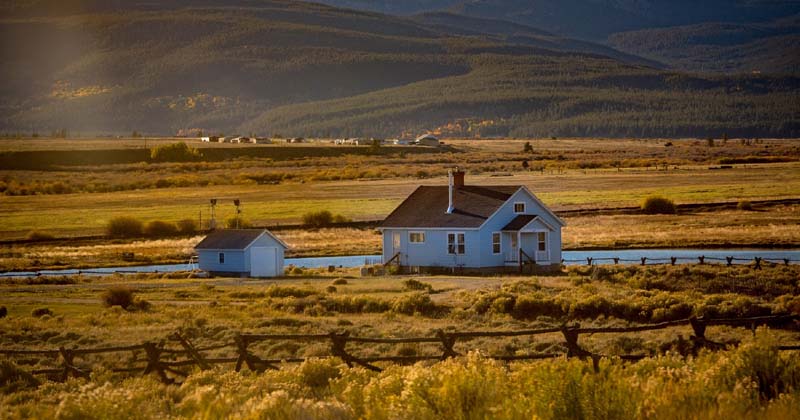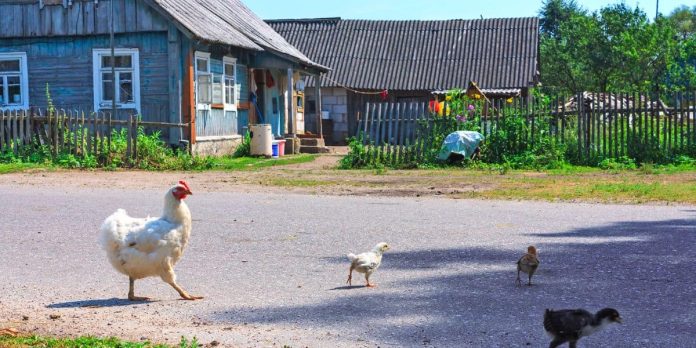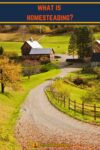For most homesteaders, the goal is simple—to live an independent, self-sufficient, and sustainable lifestyle. To accomplish this, most of us focus on meeting as many of our own needs as possible.
Whether it’s to be independent, save money, eat healthier, become better prepared, or plan for times of hardship, homesteading means leaving a materialistic lifestyle behind and embracing a do-it-yourself attitude.
A Brief History of Homesteading

Once upon a time, everyone was a homesteader. Of course, as human civilization progressed, some people became bankers, shopkeepers, etc., and fewer people were living off the land. But throughout human existence, homesteading has existed in some form.
Congress passed the Homestead Act in 1862, as well as the Southern Homestead Act in 1866, to allow any US citizen to stake a claim of public land with one stipulation. They had to live on the land and improve it for a period of five years. Then, for a small registration fee, it was theirs, free and clear.
Not only did this help develop the land to the west, but it also helped advance the manufacturing industry in the east. People needed tools and supplies to clear land, build homes, and grow their homesteads.
Although the Homestead Act wasn’t repealed until 1976, people began abandoning the homesteading lifestyle during the Industrial Revolution. Homesteading was (and still is) hard work, and in many instances, it was outright dangerous.
Little by little, people exchanged a self-sustaining lifestyle for an easier life. But now, many people are returning to the homesteading lifestyle.
Homesteading Today
Supermarkets are filled with readily available, premade foods that are easy to obtain. Not only are many of these foods packed with fillers, preservatives, and sugar, but even farming ethics and practices are being called into question.
People are beginning to recognize the cost of convenience and turning to alternatives. Little by little, homesteading has become an increasing trend.
Many of today’s homesteaders strive to embrace lifestyle and agricultural practices that were relevant throughout history while incorporating a few modern conveniences, such as emergency generators, power tools, and tractors.
They prefer to practice sustainability and agricultural ethics that are in harmony with their homes and resources, as well as the land. They take particular interest in what they put in their soil, spray on their crops, or feed their animals because it ultimately goes in their mouths.
A common misconception is that homesteading requires a lot of land (1 acre homestead layouts), but homesteaders cover many facets and live in many places:
Modern-day homesteading is less about land and more about a mindset that embraces doing what you can with what you have, no matter where you are.
Homesteading Skills
Because homesteaders ultimately strive for independence and self-sustainability, it’s a lifestyle that requires a certain set of skills, but don’t worry, not the Liam Neeson kind.
The more you delve into homesteading, the more you realize there’s always more to learn. However, these basic skills can lay a solid foundation, and many can be used regardless of your property type.
Food Independence
Food independence is traditionally at the forefront of homesteading and is typically the first step.
Growing Food
From small apartments and condos to full-sized farms, there are multiple ways you can grow food:
Whether it’s a full-fledged garden, a few house and patio plants, or hydroponics, you can grow food practically anywhere. In most cases, all you need is a little dirt and water, some good seeds, and a little creativity.
If you plan to grow your own food, be sure to develop a plan first (read how to grew the right amount of seeds for a year’s supply of food). It will probably require an initial investment, and you don’t want that investment to go to waste from a lack of proper planning.
Once you get the hang of it, you can even harvest and store your seeds for the next planting season.
Preserving Food
Once you grow your own food, it usually becomes necessary to preserve it, so it doesn’t go to waste. There are numerous methods for preserving food, and they all come with different levels of difficulty:
Many homesteaders also grow a variety of herbs and other plants, not only for cooking but for a variety of medicinal purposes (medicinal herb garden designs) and other products:
- Balms and salves
- Creams and lotions
- Dyes
- Medicinal tinctures and syrups
- Salts and scrubs
- Soaps and shampoos
- Teas
Growing whatever you can, wherever you can, saves you money and makes you a little less reliant on someone else to provide for your needs. If you can store it and save it for later, even better.
Hunting and Fishing for Food
Regardless of where you live, anyone can hunt or fish for food with proper education. Fishing is definitely the easier of the two but won’t produce as much volume. Hunting also requires the added necessities of skinning, butchering, and preserving the meat.
Be sure to research what animals are safe to hunt and eat. Many animals carry diseases and are not recommended for eating.
Most states require licensing for both fishing and hunting, and authorities typically place limits on what you can obtain. Be sure to check your state and local laws before engaging in these activities.
Animal Husbandry
You’d be surprised what you can raise on a small amount of land. Animal husbandry includes anything from a few rabbits and chickens to a whole herd of cattle and anything in between.
Most new homesteaders start with chickens to produce eggs and goats to produce milk. While this certainly isn’t an option for apartment and condo dwellers, many urban and suburban areas allow both.
Some homesteaders with land gradually transition into more abundant livestock or fowl for meat and dairy production, including rabbits, sheep, pigs, cattle (beef or dairy), turkey, meat chickens, etc. Some even raise bees for their honey.
Off-Grid Utilities
As homesteaders gain more experience, they often seek more independence. Many choose to utilize off-grid utilities, so they’re not dependent on the government or corporations for water, sewer, or electricity. See our guide to living off the grid.
As with all things homesteading, the spectrum of options is wide. Some opt for generators, composting toilets, and water entrapment systems because they’re simpler and less expensive.
Some even go so far as to have no electricity at all and utilize more primitive techniques like kerosene lamps or rechargeable lanterns. If their land has the resources, some use wood for both heating and cooking. Others opt for propane or natural gas.
Still, others acquire solar panels, wind turbines, full septic systems, and private wells. However, there’s usually a hefty investment involved. These homesteaders typically desire an independent lifestyle with all the creature comforts of electricity, running water, heating and cooling, and off grid internet.
Maintenance and Repairs
In our 21st-century world, we often pay for maintenance and repairs on many things:
- Lawns and sprinklers
- Automobiles
- Appliances
- Heating and cooling
- Fencing
When something breaks, we pay someone else to fix it. As much as possible, most homesteaders prefer to take care of these things themselves. Homesteading lifestyles involve taking advantage of your own labor instead of paying for someone else’s.
Everyone has their limitations, but the homesteading goal is always self-reliance first. As such, homesteaders are almost always learning something new. With access to the internet, you can learn to do just about anything.
Sewing and Mending
Homesteaders are usually a frugal bunch, not wanting to waste or spend anything they don’t have to. Patching, mending, and darning socks, clothes, and other items become a part of everyday life.
Making things last as long as possible is a must-have mindset for successful homesteading. Many ‘steaders even create their own textiles using their skills in sewing, quilting, or knitting/crocheting. With practice, you can use these skills to create a side hustle and earn some extra income.
Homeschooling Children
It’s not uncommon for homesteaders to homeschool their children. The reasons are many, but part of the quest for independence involves regaining control of how you spend your time.
Many seek the homesteading lifestyle to get out of the rat race and enjoy the freedom of setting their own schedules without being beholden to bell schedules, holidays, and summer vacations.
Income and Financial Freedom
Homesteading is not free, nor is it cheap. Homesteading requires money, just like everything else. The good news is homesteaders don’t need nearly as much.
Most homesteaders value financial freedom above all. You’d be surprised how little you need to live a comfortable life when you don’t have a pile of overhead.
Homesteaders make their living in a variety of ways, and it looks different for everyone. In some homesteading families, one spouse works while the other keeps the homestead running, or both spouses work part-time.
Many pursue making their homesteads profitable by selling dairy and produce or handmade products, like soaps and candles.
Others become entrepreneurs and freelancers. Many homesteaders earn an income through YouTube simply by sharing their knowledge and experiences with others.
Read: How to make money off grid
Other Skills
The homesteading journey facilitates a variety of other skills along the way. From cutting hair to cutting hay, there’s always something that needs to be done. Homesteading is definitely not a lifestyle for the lazy.
Homesteaders become jacks-of-all-trade and are constantly adding new skills to their repertoire. They work hard, enjoy their rewards, and do whatever it takes to ensure their families are provided for.
Most are more than willing to share what they know and help those in need. Ultimately, homesteading is always an adventure waiting to happen.









